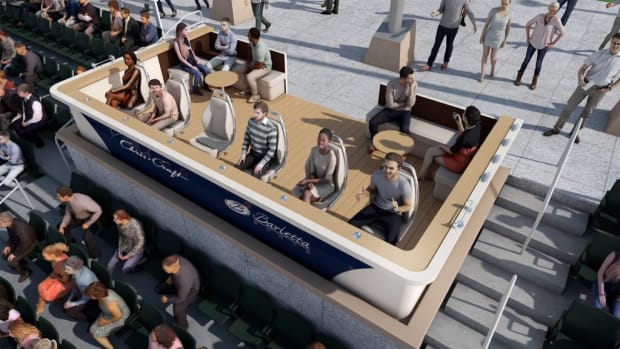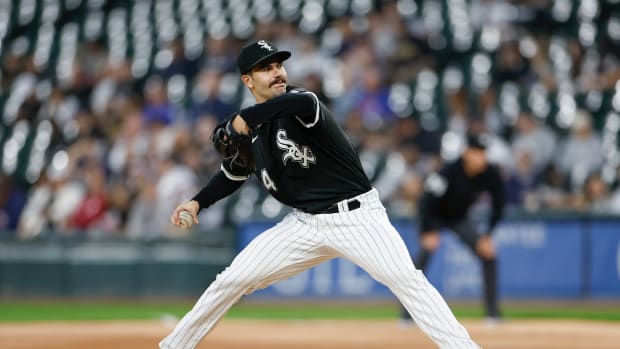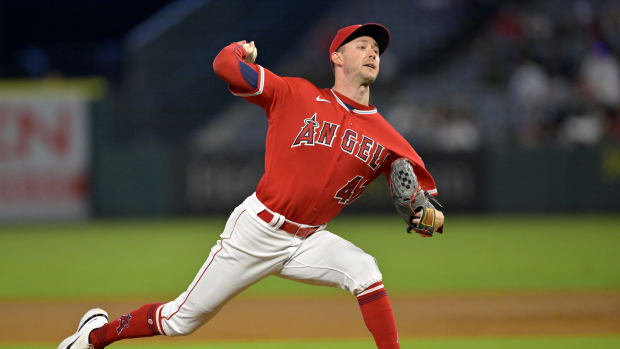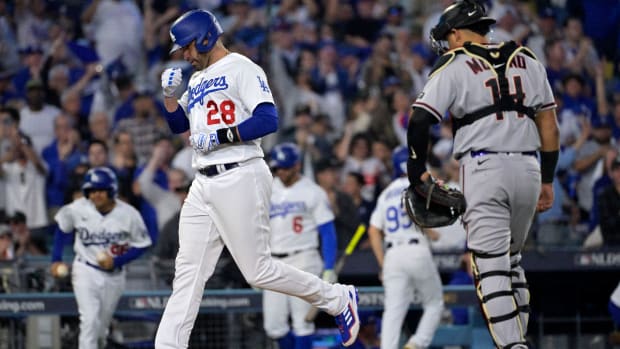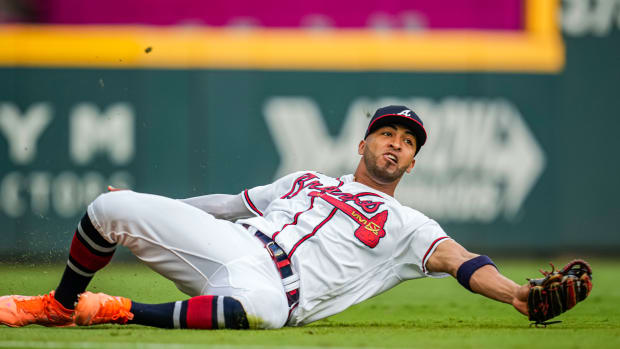NLDS Preview: Cubs vs. Dodgers
The Cubs come into the postseason with a team that makes for a study in contrasts when it comes to its assets: a broad and deep collection of hitters to attack the other team's pitchers, balanced against a stars-and-scrubs pitching staff that runs perhaps no more than six men deep before trouble arises.
They're matched up with a Dodgers team that, although it took a while, may finally be a unit, the value of whose parts in a short series probably exceeds the team's production over a whole season. With the seeming likelihood that Rafael Furcal is healthy and will lead off, the Dodgers can answer the Cubs with a lineup better than any they got to field for any extended period of time during the regular season, a lineup that can go toe to toe with Lou Piniella's charges in offensive firepower. Add in that the Dodgers' rotation boasts a pair of ace-quality starters and that the Dodgers have the one asset the Cubs lack -- a bullpen as deep and talented as the Chicago attack.
The Dodgers may have finished the season with the league's eighth-best record, but their inability to field their initially-designed team and then a set squad for any extended period of time makes it hard to evaluate them as a team as weak as their 84-78 record suggests. Using BP's Adjusted Standings and evaluating their season by strength of schedule and their own production using Clay Davenport's "third-order wins," and you get an 89-win team, whereas the Cubs should have won 94 or 95 instead of 97. While 89 wins might not sound like much, it's the fourth-best adjusted record in this season's playoff slate. What initially looks like a mismatch tightens up; add in the changes in personnel on the Dodgers roster and the seeming arrival of a now-healthy Furcal plus closer Takashi Saito, and this squares up as a much more interesting series than their relative records would have you think
In terms of team-level offense, again, cumulative full-season data portrays a mismatch that doesn't give you a realistic appreciation of the lineup the Dodgers can now actually throw out there: The Cubs wound up with a .271 team EqA, good for third in the NL and fourth in the majors, while the Dodgers finished with a definitively mediocre .260, eighth in the NL and 16th in the major leagues. So, throw out those marks for what they might lead one to conclude and instead take a look at the two lineups above: Neither one features an unproductive hitter in any of the eight slots. Admittedly, I'm indulging in some wishcasting by putting Furcal and Mark DeRosa in their teams' respective lineups. However, initial reports suggest that both are going to be available and start. In Furcal's case, given the limited sample of his incredibly hot hitting in the season's first five weeks, his more likely value is a bit overstated, but still, those are two lineups which offer their fans little or no cause for complaint.
If there's a "surprise" to some of you in the Cubs lineup, it might be the absence of Japanese import Kosuke Fukudome, but between Mike Fontenot's slugging and Fukudome's terrible second-half slump, it's really a no-brainer. It's also a reflection of Piniella's in-season flexibility as a tactician: The skipper initially started relying on Fontenot and playing DeRosa in the outfield against opposing right-handed starting pitchers when Alfonso Soriano had to go on the DL early on, and it returned to his options menu on a regular basis once Fukudome's bat went slack. Piniella also mixes in Reed Johnson in a straight center-field platoon (pulling Jim Edmonds), and also hasn't been afraid to spot Ronny Cedeno for Fontenot at second so that DeRosa can play right when the skipper wants to avoid having any lefty bats in the lineup. In short it's a lineup that, outside of their quartet of right-handed sluggers (Soriano, Derek Lee, Aramis Ramirez and Geovany Soto) provides Piniella considerable freedom of in-game action. It's old-school tactical adaptability in a competitive environment where such refinements have become virtually extinct, and it affords the Cubs the adaptability to either pinch-hit for position players or pull well-timed double-switches to avoid problems with situational matchups.
That's not to say there aren't items of concern, above and beyond DeRosa's injury. Since a red-hot April, Lee has been struggling to maintain even mediocrity as a first baseman, hitting only .275/.344/.415 since. Add in Lee's ranking among the leaders in grounding into double plays and he represents a first-order rally killer. Soto's production also tailed off a bit in September, perhaps reflecting some natural fatigue. Similarly, Theriot's to be found among the game's worst, understandable given his grounder-generating tendencies at the plate; while some percentage of those numbers are the product of hitting second behind Soriano much of the year (with the breaks on the leadoff man to avoid exacerbating his leg injuries), it makes for some squelched opportunities given the club's overall lack of speed. With only 32 unintentional walks in 506 PAs, Soriano isn't really an ideal leadoff hitter if your vision of one involves lots of free passes; in his defense, despite the reputation for not being able to bear down and drive in runners that contributes to his winding up in the leadoff slot, he ranks third among the team's regulars in OBI% with 16.4 in terms of his rate of baserunners driven in.
The Dodgers' lineup radically altered its fortunes with the Manny Ramirez deal: In the two months since, they've averaged 4.6 runs per game after scoring 4.2 before. Even that understates the impact of adding Ramirez (and Casey Blake, to a significantly lesser extent), in that the Dodgers were actually down to 3.7 runs per game in the 76 games after losing Furcal before adding Manny. That's the kind of poor production that encourages you to try things like returning Nomar Garciaparra to short, but this is no longer the team running Angel Berroa out there on a regular basis. If Furcal's really close enough to 100 percent, it isn't implausible to suggest that the Dodgers are a five-run-per-game offense, ranking with the Cubs' league-leading 5.3 clip. Getting Furcal back also allows the Dodgers to shift some things around, like getting to move away from picking between Matt Kemp and the slumping Russell Martin for the leadoff slot. It should put both players where their offensive contributions mesh more suitably: Martin's OBP still should serve in the second slot, and Joe Torre's recent attempt to rest his regular backstop will ideally provide some dividends, while Kemp's ability to make contact and deliver consistent power on contact is more serviceable lower in the order. Batting Andre Ethier and James Loney back to back might seem unorthodox, since Torre's big on alternating by handedness to protect himself against a situational lefty getting a good run of batters to face, but the Cubs don't have a good lefty, so Torre can pretty much do as he pleases here. Ethier in particular could shine, between his post-Manny breakout (.360/.442/.640 from Aug. 1 on) and the perhaps-related willingness by Torre to leave him be. Loney may nevertheless get platooned and sat down in the fourth game (if the series gets there), in that his hitting against lefties (.249/.303/.361) provides a ready excuse for Torre to plug in either Jeff Kent or Garciaparra at first.
The concerns with L.A.'s lineup are related to some of the points noted with the Cubs. Martin's real problem in the second half was that his power went away: Hitting .260/.371/.336 is serviceable, but if he wasn't hitting with authority, people are going to wonder whether GM Ned Colletti really should have given more thought to acquiring a reserve better than the execrable Gary Bennett or the equally well-traveled Danny Ardoin. If Lee's a double-play threat, Loney has him beat, ranking third among all major leaguers in NetDP where Lee rates 12th. With relatively immobile hitters on base ahead of him, and with his season representing an already altogether massive disappointment for Dodgers fans, Loney gives this series another first baseman as likely to wind up a goat as a hero. Blake's production with the Dodgers looks nice enough, but after plating 20.6 percent of his baserunners as an Indian he has slumped to driving in a miserable team-low 7.6 percent with the Dodgers. I'll leave it to you to decide what that's supposed to mean as far as whether he's clutch, unclutch, sort of clutch or another reason why we should recognize that "clutch" is an adjective, and not necessarily a skill.
If there's an odd, fun factoid to ponder, it isn't often that you might be able to argue that two potent offenses are so strong top to bottom that their respective first basemen might be their weakest links, but that's the funny thing about these two lineups -- it's almost true. Edmonds' numbers are his combined totals with the Cubs and Padres, which take his overall Cub numbers (.301 EqA, 23.1 VORP) down several pegs. Sure, Theriot and Blake DeWitt aren't outhitting Loney and Lee, but they're both contributing healthy doses of OBP from middle-infield lineup slots, and it's harder to find those than first basemen a little light in the slugging department.
Whether or not DeRosa can go, expect Fukudome to spot-start against Chad Billingsley, given his extreme vulnerability to lefty hitters. However, the import's second-half slump (.217/.314/.326 since the All-Star break) makes for pretty dubious utility, even for platoon advantage purposes. Daryle Ward isn't especially playable in the outfield, though, nor is Michah Hoffpauir should Piniella elect to keep the organizational slugger over Felix Pie's uses as a defensive replacement and pinch-runner. Certainly, between Ward and Hoffpauir, Piniella would have pinch-hitting a-plenty. Johnson's reputation as a speed player is really just a suds-soaked Wrigleyville pink elephant-level mirage -- he's what he was as a Blue Jay, a contact hitter with value against lefties, and stretched more than a little afield as Edmonds' platoon partner in center. Henry Blanco's not this effective a hitter, but being gifted with garbage time makes for an easy way to avoid over-exposure; while he remains an effective catch-and-throw type, only anticipate seeing him if Piniella has cause to give Soto some time off, or elects to pinch-run for him. Even that's unlikely, in that it would require a selection of Pie over Hoffpauir.
Now that Torre's belatedly sorted out that Juan Pierre's charms are better enjoyed as you fly far above them, the opportunity is definitely there to employ Pierre to best effect -- as Manny Ramirez's legs, perhaps, in the bottom of the eighth or ninth at home, or for any of the second base options, or Loney... you get the idea. The Dave Roberts-as-post-season-hero scenario isn't that complicated, and it's the one chance Pierre has to demonstrate actual tactical value on a scale that magnifies his virtues. Beyond Pierre, the Dodgers have Kent and Garciaparra to plug in anywhere around the horn (Nomar anywhere but second, Kent only on the right side), choose between as starting alternatives at first base against Ted Lilly and use as high-leverage pinch-hitters. Again, it's the postseason, so as with Pierre, set aside the expense and embrace their virtues. As for the rest, if you see Ardoin or Berroa or Pablo Ozuna on the field, we're either in extras or things are going very badly or very well (with no room in between).
Because the Cubs and Dodgers finished their season series in early June, it's hard to know what to expect. Rich Harden didn't have to face this team, for example, but even if he'd been a Cub at the time he wouldn't have seen the Manny-enhanced Dodgers lineup, and by the time these clubs matched up against one another the first time, Furcal was already on the DL. Advantages may well go to the pitcher in these circumstances, but the interesting dilemma is that there's a good amount of unknowns when it comes to how the Cubs' rotation matches up with the Dodgers'. Chicago may have the name pitchers and the personalities, but here again this isn't as cut-and-dried an advantage as it might appear at first glance. With the questions over whether or not Carlos Zambrano or Harden have gas in the tank, and reasonable doubts over Ryan Dempster's performance against top teams, this almost becomes a matter of faith. Harden's one of the best pitchers in baseball when he's sound; will the careful management of him that Piniella exhibited during the regular season mean that he now opens up the throttle and leaves Harden in late, to avoid that ghastly pen? BP's Will Carroll has noted that Zambrano's inconsistency and arm-slot issues make him a bit of an adventure: Can he rise to this challenge as he did in his no-hitter against the Astros, or is he worn down to a nub? Will the dominant pitcher that Dempster has been in Wrigley Field (2.9 RA/9 at home, 3.8 on the road) make all the difference in his first- and fifth-game assignments?
While there's still a question over whether or not Greg Maddux will start the fourth game of the series -- perhaps if the Dodgers are up 2-1 -- the Cubs might consider that a mercy, because the Dodgers' front three managed quality starts in five of six games against Chicago this season, with only Billingsley falling short. Lowe's cruising, having logged 10 quality starts in his last 13 (and one of the three was a quick-hook tuneup to wrap up the regular season, in which he threw three shutout innings against the Giants). In that time he's gone 7-3, posted a 2.09 ERA and allowed just 78 baserunners in 81 2/3 IP. Add in that he's not showing the big platoon split from years past (and in a perhaps-related development, throwing his slider much more frequently), and the worm-killer's enjoying his best-ever season as a rotation regular, and truly graduating to ace-level performance. Billingsley's big-talent rep comes with a noteworthy chink in his armor: While he has dominated right-handers by limiting them to .225/.283/.338, lefties aren't biting on his off-speed stuff, touching him for .263/.369/.391. Hiroki Kuroda's sinker/slider mix has similarly mowed down right-handers (.246/.292/.319 this year), making the Cubs' righty-heavy lineup all that much more vulnerable.
Effectively, what this really means is that however great the potential for the Cubs' starters to spin dominating outings -- if Harden and Zambrano are at their best and if Dempster keeps on keeping on in the Friendly Confines -- the problem is that they might absolutely need for them to be, because the Dodgers have a hot trio well-equipped to attack a righty-heavy lineup, and almost equally likely to fashion a dominant outing or two of their own.
The Dodgers might be the team that lost its closer for most of the second half, but it's the Cubs whose second-half performance has been a major problem. As Jay Jaffe noted two weeks ago, positive pen performance for the Piniellans was a product of the season's first part. In the first half the Cubs' pen finished an adequate 12th in the majors in FRA; in the second they fell to 20th. In both the first half and the second, they had Kerry Wood and Carlos Marmol... and very little else; the Dodgers lost Saito and unsung middle-relief fireman Cory Wade for extended periods of time, and followed up their first-half performance (third in the majors in FRA) by ranking sixth in the second. In short this is a unit with the talent to work around Saito's likely limitation to not be available to pitch on consecutive days.
For the Cubs, this is very clearly a stars-and-scrubs setup. If they wind up trying to win games and matchups with Bobby Howry, Jeff Samardzija or Neal Cotts, they'll be rolling the dice. While going after Ethier or Loney in key mid-game situations with a solid situational lefty makes sense, neither Cotts nor Sean Marshall have been at all effective in the role. If, on the other hand, the rotation carries leads into the seventh inning, they're into Marmol territory. And while Wood had problems getting lefties to bite on his breaking stuff as a starter, as a full-time reliever his slider seems to have added bite, on top of some added oomph on his fastball. In other words they're the perfect tandem to protect late-game leads.
In contrast the Dodgers have the depth and the talent in the pen to win a game in the middle frames, and can attack opponents with a broad assortment of weapons. Whether Wade's curveball and uncanny ability to work with men on base, Jonathan Broxton's pure power mix of mid-90s heat and high-80s slider, Joe Beimel's relative reliability or Chan Ho Park's starterly variety, Torre has an exceptional crew to call upon as needed. The interesting addition to the pen is Clayton Kershaw, perhaps in an altruistic effort to control his workload, but perhaps also more practically as a way to add an exceptionally talented lefty to the mix to work multiple innings in relief should a starter need to leave early. There's also Ramon Troncoso, who clocks consistently in the 90s, but perhaps more importantly spared the Dodgers from keeping Scott Proctor because of his ability to keep throwing 90 and stay loose after warming up a couple of times in-game. Consider that kind of physical gift a sign of the times.
Score this a definite Cubs advantage, because they rank second in the majors in straight Defensive Efficiency, and first in park-adjusted defensive efficiency. None of the Cubs' infielders are exceptional, but all are effective enough, while their outfield combinations, however often Soriano's clumsiness causes scares, work effectively. Fontenot represents a slight upgrade on DeRosa at second, adding to the benefit that comes from playing him, even if it costs them Fukudome's rangy play in right. Soto's slightly better at deterring the running game than Martin, perhaps evening out the Dodgers' slight advantage in speed among their top base stealers.
The Dodgers might be a storied franchise, but one important part of the story has been a willingness to move people around the diamond that borders on institutional, and not merely historic. Whether returning Garciaparra to short (out of desperation), trying DeWitt at second (out of desperation), or smiling their way through Manny's diffident play in left (need I repeat the obvious?), the Dodgers have been as gloriously indifferent to glove work now as they were in the Lasorda days, or even back when they were willing to make Davey Lopes, Bill Russell and Steve Garvey move around the diamond because... well, it made sense. Admittedly, accepting Manny's brand of cheery incompetence means that Kemp and Ethier wind up in positions where they're not exactly exceptional, but with Kuroda and Lowe relying on ground-ball outs and Billingsley getting a healthy chunk of his outs at the plate, this is more survivable for the front three than it is for, say, Maddux. The man who doesn't help them any in the infield is Blake, but that's less of a disaster if they have Furcal around to cover the hole at short.
As a true product of the '80s, Piniella is easily the more nimble manager on offense, but given the Dodgers' quality starting pitching and deep pen, he may well need to avoid losing control of games where L.A.'s pitching comes to the fore. In contrast, Torre's willingness to ride relievers hard and play a relatively set lineup may serve him well -- there's plenty of junk worth avoiding on the Dodgers' bench, and relegating formerly famous people like Garciaparra or Kent to high-leverage pinch-hitting roles might make either man a newly-minted Dodgers post-season hero. In terms of in-game tactics, neither manager is overly fancy; Torre hasn't bunted much with position players not named Pierre or Berroa, while Piniella's a bit more bunt-happy with his non-pitchers (perhaps one of the side effects of having great-hitting pitchers like Zambrano and Jason Marquis). Both men let the players who can, run, but the distinction is that Torre's got faster horses in Kemp, Pierre and Martin. If a game goes to extra innings, the interesting problem there is whether Piniella's variety and strength on his fully-stocked bench can beat the equally strong Dodgers pen, or if the relatively weak group of Dodgers reserves can help out all that much against the Cubs' weak assortment of third-rank relievers pressed into second-rate responsibilities.
It's that pen which might save the Dodgers from the kind of outsized matchup that the fourth game might otherwise appear to be, because that might also spare them from attempting to start Lowe on short rest, something that has yet to produce a quality start in the four times it has been tried in the L.A. portion of his career. Nevertheless, I still see this winding up as a Cubs series win in five, perhaps something of an upset considering the relative perceived virtues of the two clubs, but a victory that will be worth watching and hard-fought. I guess if I sketch out a scenario and take it to some fanciful conclusions, I can foresee a split between the two teams in the Lowe-Dempster matchup, a Cubs' win in the second game after losing the opener, a pitcher's duel in the third game that comes out with Big Z adding something to his legend, a pen-led win by the Dodgers in the fourth game that involves some Manny heroics at Lilly's expense, all capped by a Dempster gem for the folks at home. As long as I'm predictin', may as well aim high, right?






























